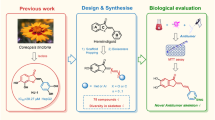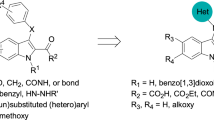Abstract
Two new series of aurone compounds were synthesized via an oxidative cyclization reaction of 2′-hydroxy-chalcones. Series (A) consists of 1a–3a aurones with different substitutions on a B-ring at position 4′, and series (B) is made up of 1b–3b aurones that have different substitutions at position 2′ of a B-ring. Structures of the synthesized compounds were characterized and confirmed by FTIR (1D and 2D NMR) and EI mass spectral studies. The molecular structure of 2b was further confirmed by the X-ray crystallographic technique, with the compound found to be in Z-isomeric form. The compounds of both series were tested for their antiproliferative activity against human colorectal tumor (HCT 116), human chronic myelogenous leukemia (K562) and hormone-dependent breast cancer (MCF-7) cell lines according to an MTT assay. Series (B) exhibited a higher cytotoxic effect on the cancer cell lines compared to series (A). Selectively, the most promising results have been shown by the two most active compounds, 1b (Z-5,7, 2′-trichloro-aurone), which resulted in IC50 values of 36, 23 and 23 μM against HCT 116, MCF-7 and K562 cancer cells, respectively. Compound 3a (Z-5, 7-dichloro-4′-methyl-aurone) exhibited the highest activity against the K562 cell line (IC50 = 20 μM), which can be compared to that of the standard drug, betulinic acid, with an IC50 value of 15 μM. The results of the present study suggested that aurone derivatives emerged as a potential candidate for the development of future chemotherapeutic agents.









Similar content being viewed by others
References
Agrawal PK (1989) Carbon-13 NMR of flavonoids. Elsevier, Amsterdam
Ahamed MBK, Aisha AF, Nassar ZD, Siddiqui JM, Ismail Z, Omari S, Parish C, Majid AA (2012) Cat’s whiskers tea (Orthosiphon stamineus) extract inhibits growth of colon tumor in nude mice and angiogenesis in endothelial cells via suppressing VEGFR phosphorylation. Nutr Cancer 64(1):89–99
Arshad A, Osman H, Bagley MC, Lam CK, Mohamad S, Zahariluddin ASM (2011) Synthesis and antimicrobial properties of some new thiazolyl coumarin derivatives. Eur J Med Chem 46(9):3788–3794
Atta-Ur-Rahman, Muhammad Iqbal C, Hayat S, Khan AM, Ahmed A (2001) Two new aurones from marine brown alga Spatoglossum variabile. Chem Pharm Bull 49(1):105–107
Bandgar BP, Patil SA, Korbad BL, Biradar SC, Nile SN, Khobragade CN (2010) Synthesis and biological evaluation of a novel series of 2, 2-bisaminomethylated aurone analogues as anti-inflammatory and antimicrobial agents. Eur J Med Chem 45(7):3223–3227
Bernstein J, Davis RE, Shimoni L, Chang NL (1995) Patterns in hydrogen bonding: functionality and graph set analysis in crystals. Angew Chem Int Edit 34(15):1555–1573
Bolek D, Gutschow M (2005) Preparation of 4,6,3′,4′-tetrasubstituted aurones via aluminium oxide-catalyzed condensation. J Heterocyclic Chem 42(7):1399
Bruker (2005) APEX2, SAINT and SADABS. Bruker AXS Inc, Madison
Chu H-W, Wu H-T, Lee Y-J (2004) Regioselective hydroxylation of 2-hydroxychalcones by dimethyldioxirane towards polymethoxylated flavonoids. Tetrahedron 60(11):2647–2655
Cragg GM, Newman DJ (2005) Plants as a source of anti-cancer agents. J Ethnopharmacol 100(1–2):72–79
Detsi A, Majdalani M, Kontogiorgis CA, Hadjipavlou-Litina D, Kefalas P (2009) Natural and synthetic 2′-hydroxy-chalcones and aurones: synthesis, characterization and evaluation of the antioxidant and soybean lipoxygenase inhibitory activity. Bioorg Med Chem 17(23):8073–8085
Dewar MJS, Zoebisch EG, Healy EF, Stewar JJP (1985) Development and use of quantum mechanical molecular models 76 AM1: a new general purpose quantum mechanical molecular model. J Am Chem Soc 107:13
Ferlay J, Soerjomataram I, Dikshit R, Eser S, Mathers C, Rebelo M, Bray F (2015) Cancer incidence and mortality worldwide: sources, methods and major patterns in GLOBOCAN 2012. Int J Cancer 136(5):E359–E386
Haque RA, Iqbal MA, Asekunowo P, Majid AA, Ahamed MBK, Umar MI, Al-Rawi SS, Al-Suede FSR (2013) Synthesis, structure, anticancer, and antioxidant activity of para-xylyl linked bis-benzimidazolium salts and respective dinuclear Ag (I) N-heterocyclic carbene complexes (part-II). Med Chem Res 22(10):4663–4676
Huang W, Liu MZ, Li Y, Tan Y, Yang GF (2007) Design, syntheses, and antitumor activity of novel chromone and aurone derivatives. Bioorg Med Chem 15(15):5191–5197
Lawrence NJ, Rennison D, McGown AT, Hadfield JA (2003) The total synthesis of an aurone isolated from Uvaria hamiltonii: aurones and flavones as anticancer agents. Bioorg Med Chem Lett 13(21):3759–3763
Morimoto M, Fukumoto H, Nozoe T, Hagiwara A, Komai K (2007) Synthesis and insect antifeedant activity of aurones against Spodoptera litura larvae. J Agr Food Chem 55(3):700–705
Murias M, Jäger W, Handler N, Erker T, Horvath Z, Szekeres T, Gille L (2005) Antioxidant, prooxidant and cytotoxic activity of hydroxylated resveratrol analogues: structure–activity relationship. Biochem Pharmacol 69(6):903–912. doi:10.1016/j.bcp.2004.12.001
Narsinghani T, Sharma MC, Bhargav S (2013) Synthesis, docking studies and antioxidant activity of some chalcone and aurone derivatives. Med Chem Res 22(9):4059–4068
Newman DJ, Cragg GM (2012) Natural products as sources of new drugs over the 30 years from 1981 to 2010. J Nat Prod 75(3):311–335
Okombi S, Rival D, Bonnet S, Mariotte AM, Perrier E, Boumendjel A (2006) Discovery of benzylidenebenzofuran-3 (2H)-one (aurones) as inhibitors of tyrosinase derived from human melanocytes. J Med Chem 49(1):329–333
Pelter A, Ward RS, Heller HG (1979) Carbon-13 nuclear magnetic resonance spectra of (Z)-and (E)-aurones. J Chem Soc Perkin Trans 1:328–329
Roussaki M, Costa Lima S, Kypreou AM, Kefalas P, Cordeiro da Silva A, Detsi A (2012) Aurones: a promising heterocyclic scaffold for the development of potent antileishmanial agents. Int J Med Chem. doi:10.1155/2012/196921
Seabra RM, Andrade PB, Ferreres F, Moreira MM (1997) Methoxylated aurones from cyperus capitatus. Phytochemistry 45(4):839–840
Sheldrick GM (2007) A short history of SHELX. Acta Crystallogr A 64(1):112–122
Siegel R, Naishadham D, Jemal A (2013) Cancer statistics, 2013. CA: CA-Cancer J Clin 63(1):11–30
Spek AL (2009) Structure validation in chemical crystallography. Acta Crystallogr D 65(2):148–155
Venkateswarlu S, Panchagnula GK, Subbaraju GV (2004) Synthesis and antioxidative activity of 3′,4′,6,7-tetrahydroxyaurone, a metabolite of Bidens frondosa. Biosci Biotechnol Biochem 68(10):2183–2185
Venkateswarlu S, Panchagnula GK, Gottumukkala AL, Subbaraju GV (2007) Synthesis, structural revision, and biological activities of 4′-chloroaurone, a metabolite of marine brown alga Spatoglossum variabile. Tetrahedron 63(29):6909–6914
Acknowledgments
We thank Universiti Sains Malaysia (USM) for functional support through a Research University (RU) Grant (1001/PKIMIA/811221). The authors would also like to acknowledge the RU Grant of USM (RUT 1001/PKIMIA/855006) for financial support for the project. Aboubaker A. Elhadi thanks the Libyan government for the Ph.D. scholarship.
Author information
Authors and Affiliations
Corresponding author
Electronic supplementary material
Below is the link to the electronic supplementary material.
Rights and permissions
About this article
Cite this article
Elhadi, A.A., Osman, H., Iqbal, M.A. et al. Synthesis and structural elucidation of two new series of aurone derivatives as potent inhibitors against the proliferation of human cancer cells. Med Chem Res 24, 3504–3515 (2015). https://doi.org/10.1007/s00044-015-1400-2
Received:
Accepted:
Published:
Issue Date:
DOI: https://doi.org/10.1007/s00044-015-1400-2




